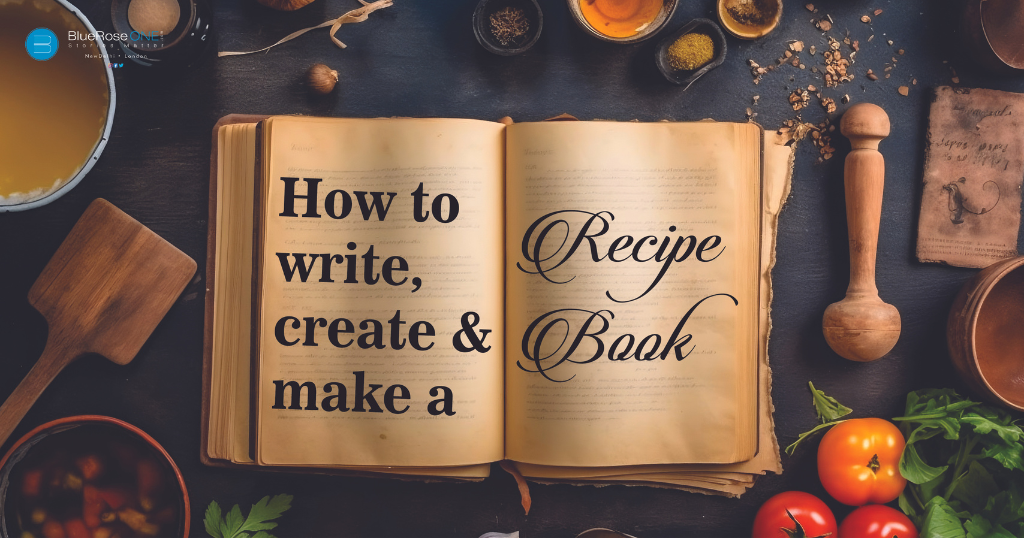Do you have a passion for cooking and want to share your culinary creations with the world? Creating your own recipe book or cookbook is a fantastic way to do just that. Not only can you document your favourite recipes, but you can also craft a beautifully designed book to inspire others in the kitchen.
Read: How to Write and Create a Compelling Book Blurb for Your Bestseller: Easy Hacks to Rely upon.
In this comprehensive guide, we’ll take you through the steps of how to make your very own recipe book, answer common questions, and explore the exciting world of cookbook creation.
How Do I Make My Own Cookbook?
Creating your own cookbook might sound like a daunting task, but with careful planning and organisation, it can be an enjoyable and rewarding project. Here’s a step-by-step guide to help you get started:
- Step 1: Define Your Cookbook’s Purpose
Before embarking on the creation of your cookbook, it is crucial to have a clear understanding of its purpose and theme. Are you aiming to compile a collection of cherished family recipes, explore a specific cuisine, or cater to dietary preferences such as vegan or gluten-free? Defining the purpose of your cookbook provides a roadmap for the content that you will include. This initial decision will guide your recipe selection, writing style, and design choices throughout the project, ensuring a cohesive and engaging final product. - Step 2: Gather Your Recipes
To begin crafting your cookbook, gather all the recipes you intend to include. These recipes can be your original creations, beloved family traditions, or even dishes you’ve discovered and fallen in love with. It’s crucial that the recipes are thoroughly tested and written in a clear, concise manner. A well-organised collection of recipes forms the foundation of your cookbook and ensures that your readers can successfully recreate the dishes you’re presenting. - Step 3: Organise and categorise
Organising your recipes into logical categories is a key step in creating a user-friendly cookbook. Consider categorising recipes by course (appetisers, mains, desserts), ingredients (e.g., chicken, pasta), or occasions (e.g., holidays, special events). Logical grouping makes it easier for readers to navigate your cookbook, find recipes that suit their needs, and enhance their overall experience. - Step 4: Write your introductions.
Crafting engaging and informative introductions is vital to setting the tone for your cookbook. In your introductions, explain the cookbook’s theme and your personal passion for cooking, and share any relevant anecdotes or stories related to the recipes. These introductions provide readers with context and a deeper connection to your culinary journey, making your cookbook more engaging and relatable. - Step 5: Include High-Quality Photography
High-quality food photography can significantly enhance the visual appeal of your cookbook. Invest in professional photography or hone your photography skills to capture your dishes beautifully. Ensure that your food images are well-lit, showcase the textures and colours of the dishes, and make readers eager to try the recipes. Stunning visuals complement your recipes and create a visual feast for your readers. - Step 6: Design Your Cookbook
Deciding on the layout and design of your cookbook is a creative and crucial step. You can use design software or collaborate with a professional designer to create an aesthetically pleasing book. Pay careful attention to fonts, colours, and formatting to ensure consistency throughout the cookbook. An appealing design not only makes your cookbook visually attractive but also contributes to a seamless and enjoyable reading experience. - Step 7: Write recipe instructions.
Clear and concise recipe instructions are fundamental to the success of your cookbook. Write each recipe with attention to detail, including ingredient lists, step-by-step directions, and any additional tips or variations. Ensure that your instructions are easy to follow, even for novice cooks. Clarity and precision in your recipes empower readers to recreate your dishes successfully. - Step 8: Proofread and Edit
Thoroughly proofreading your cookbook is essential to maintaining its professionalism and readability. Check for spelling, grammar, and formatting errors. Consider seeking the help of a professional editor or enlisting a second set of eyes to review your content. An error-free cookbook enhances your credibility as an author and ensures that your readers have a seamless experience. - Step 9: Choose Publishing Options
Deciding on the book publishing format that best suits your goals. You can opt for a physical printed book, a digital e-book, or both. Research different publishing options, whether through self-publishing platforms or traditional publishing routes, to determine the most suitable approach for your cookbook project. - Step 10: Promote Your Cookbook
Once your cookbook is complete, it’s time to spread the word. Utilise social media, food blogs, and other online platforms to promote your cookbook. Consider hosting cooking demonstrations, collaborating with influencers, or participating in culinary events to generate buzz. Encourage reviews and feedback from your readers to build a community of food enthusiasts around your cookbook, increasing its reach and impact. Effective promotion is key to the success of your culinary creation.
You may also like: Guide to Self Publishing on Amazon Kindle Direct Publishing
How Do You Make a Recipe Book Step by Step?
Now, let’s break down the process into more detailed steps:
- Step 1: Planning
Begin the planning step by conceptualising the topic of your cookbook and defining your target audience. Consider what makes your cookbook special as well as who it is intended for. Create a table of contents to order your recipes, ensuring that they flow logically and cater to the tastes of your audience. This first phase establishes a clear framework for the content and organisation of your cookbook. - Step 2: Recipe Selection
Gather the recipes you want to include in your cookbook and make sure they’re tried and true. Consider the seasonality of your ingredients to ensure that your cookbook contains recipes that can be cooked all year. To cater to a wide audience, aim for variety in your recipe selections, encompassing diverse cuisines, culinary skills, and dietary preferences. - Step 3: Writing and Formatting
Write your recipes with clarity, including precise ingredient lists and step-by-step instructions. Ensure that each recipe is easy for readers to follow, regardless of their cooking skill level. Pay attention to consistent formatting, such as fonts and layouts, throughout your cookbook. Uniform formatting enhances readability and creates a cohesive visual experience. - Step 4: Photography
Invest in high-quality food photography to promote your delicacies attractively. Consider hiring a professional photographer who specialises in food photography. Capture your recipes from various perspectives and situations to generate aesthetically attractive photographs that interest readers and assist them in visualising the final product. - Step 5: Design
Design your cookbook’s layout thoughtfully, either personally or with the assistance of a professional designer. Choose a cohesive colour scheme and typography that aligns with your cookbook’s theme and appeals to your target audience. Effective design not only enhances aesthetic appeal but also contributes to the overall user experience. - Step 6: Proofreading and Editing
Thoroughly proofread and edit your cookbook to eliminate errors and ensure accuracy. Pay particular attention to measurements, cooking times, and ingredient quantities to guarantee that readers can replicate your recipes successfully. A meticulously reviewed cookbook adds to your credibility as an author and ensures that readers can trust your instructions. - Step 7: Publishing
Choose the best book publication format for your needs, whether it’s a printed book, a digital e-book, or a combination of the two. Investigate various publication possibilities, such as self-publishing platforms, established publishers, and hybrid techniques. Consider the benefits and drawbacks of each strategy before deciding which one is ideal for your cookbook project. - Step 8: Marketing
Create a complete marketing strategy to properly promote your cookbook. To generate interest in your cookbook, use social media channels, engage with food bloggers, and attend culinary events. Engage your target audience, create excitement, and encourage pre-orders or sales. A well-executed marketing plan is critical to attracting a large readership and ensuring your cookbook’s success.
You may also like: 5 Act Structure: Definition, Examples and More
How Do You Create a Recipe Book for Free?
Creating a recipe book for free is possible with the right tools and resources. Here’s how:
- Use Free Design Software: Platforms like Canva offer free design templates for creating cookbooks. You can customise layouts, fonts, and images.
- Open-Source Publishing: Consider open-source publishing platforms like Pressbooks, which allow you to create and publish digital books for free.
- Digital-Only Publication: Opt for a digital-only cookbook, which eliminates printing costs. You can distribute it as a PDF or through e-book platforms.
- Crowdfunding: Explore crowdfunding options to cover expenses. Websites like Kickstarter can help you raise funds for your cookbook project.
Do recipe books make money?
Recipe books can be profitable, but success depends on various factors:
- Audience: A well-defined target audience increases your chances of success.
- Marketing: Effective promotion and marketing are crucial for sales.
- Quality: High-quality content, including recipes and photography, attracts buyers.
- Distribution: Consider both online and offline sales channels to reach a broader audience.
- Unique Selling Proposition: Differentiate your cookbook with a unique theme or approach.
Remember that cookbook publishing often involves upfront costs, so careful planning and marketing are essential to making a profit.
Read: How to pick between Paperback, Hardcover, Ebook – What’s best for you?
In conclusion, creating your own recipe book or cookbook is an exciting journey that allows you to share your love for cooking with others. By following these steps and considering your options, you can bring your culinary creations to life and even turn your passion into a profitable venture.
















